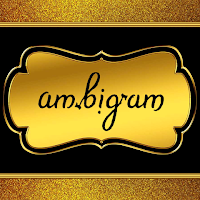Most ambigrams are visual
palindromes that rely on some kind of symmetry, and they can often be
interpreted as visual puns.
The term was coined by
Douglas Hofstadter in 1983–1984.
Most often, ambigrams appear
as visually symmetrical words.
When flipped, they remain
unchanged, or they mutate to reveal another meaning. "Half-turn"
ambigrams undergo a point reflection (180-degree rotational symmetry) and can
be read upside down, while mirror ambigrams have axial symmetry and can be read
through a reflective surface like a mirror. Many other types of ambigrams exist.
Ambigrams can be constructed
in various languages and alphabets, and the notion often extends to numbers and
other symbols.
It is a recent
interdisciplinary concept, combining art, literature, mathematics, cognition,
and optical illusions.
Drawing symmetrical words
constitutes also a recreational activity for amateurs.
Numerous ambigram logos are
famous, and ambigram tattoos have become increasingly popular.
There are methods to design
an ambigram, a field in which some artists have become specialists.
History
Many ambigrams can be
described as graphic palindromes.
The first Sator square
palindrome was found in the ruins of Pompeii, meaning it was created before the
Eruption of Mount Vesuvius in 79 AD.
A sator square using the
mirror writing for the representation of the letters S and N was carved in a
stone wall in Oppède (France) between the Roman Empire and the Middle Ages,
thus producing a work made up of 25 letters and 8 different characters, 3
naturally symmetrical (A, T, O), 3 others decipherable from left to right (R,
P, E), and 2 others from right to left (S, N).
This engraving is therefore
readable in four directions.
Although the term is recent,
the existence of mirror ambigrams has been attested since at least the first
millennium.
They are generally
palindromes stylized to be visually symmetrical.
In ancient Greek, the phrase
"ΝΙΨΟΝ ΑΝΟΜΗΜΑΤΑ ΜΗ ΜΟΝΑΝ ΟΨΙΝ" (wash the sins, not only the face),
is a palindrome found in several locations, including the site of the church
Hagia Sophia in Turkey.
It is sometimes turned into
a mirror ambigram when written in capital letters with the removal of spaces,
and the stylization of the letter Ν (Ν).
A boustrophedon is a type of
bi-directional text, mostly seen in ancient manuscripts and other inscriptions.
Every other line of writing
is flipped or reversed, with reversed letters.
Rather than going
left-to-right as in modern European languages, or right-to-left as in Arabic
and Hebrew, alternate lines in boustrophedon must be read in opposite
directions.
Also, the individual
characters are reversed, or mirrored.
This two-way writing system
reveals that modern ambigrams can have quite ancient origins, with an intuitive
component in some minds.
The earliest known
non-natural rotational ambigram dates to 1893 by artist Peter Newell.
Although better known for
his children's books and illustrations for Mark Twain and Lewis Carroll, he
published two books of reversible illustrations, in which the picture turns
into a different image entirely when flipped upside down.
The last page in his book
Topsys & Turvys contains the phrase The end, which, when inverted, reads
Puzzle. In Topsys & Turvys Number 2 (1902), Newell ended with a variation
on the ambigram in which The end changes into Puzzle 2.
In March 1904 the
Dutch-American comic artist Gustave Verbeek used ambigrams in three consecutive
strips of The UpsideDowns of old man Muffaroo and little lady Lovekins.
His comics were ambiguous images, made in such a way that one could read the six-panel comic, flip the book and keep reading.
From June to September 1908,
the British monthly The Strand Magazine published a series of ambigrams by
different people in its "Curiosities" column.
Of particular interest is
the fact that all four of the people submitting ambigrams believed them to be a
rare property of particular words. Mitchell T. Lavin, whose "chump"
was published in June, wrote, "I think it is in the only word in the
English language which has this peculiarity," while Clarence Williams
wrote, about his "Bet" ambigram, "Possibly B is the only letter
of the alphabet that will produce such an interesting anomaly."
Look it up on Wikipedia


No comments:
Click Here To add Comment
Post a Comment
Blogger Widgets